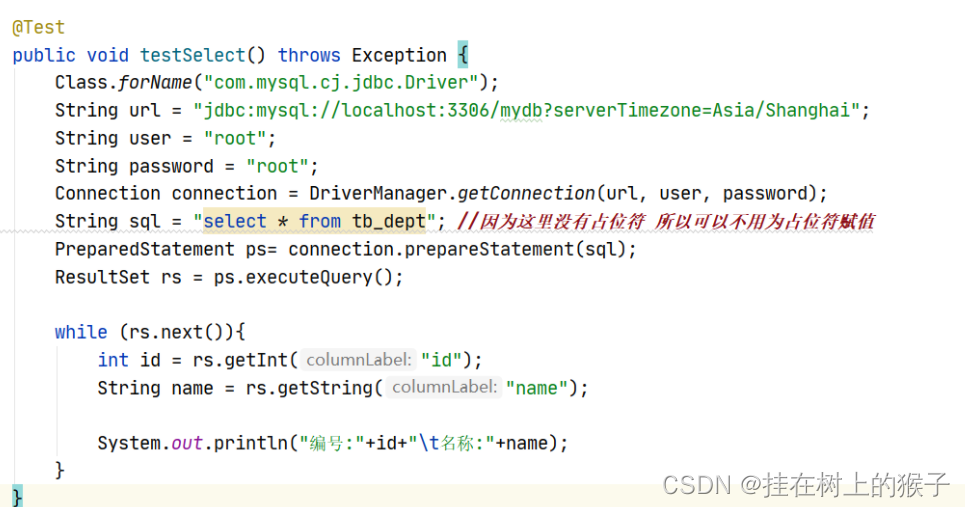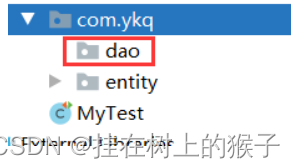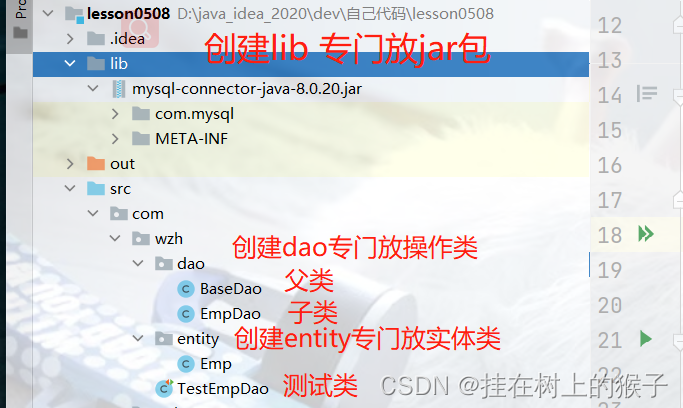目录
3.对每张表的操作封装到相应的类上(操作类)--对应的Dao类
1.回顾
1. jdbc--查询功能。
2. sql注入的安全问题解决方案.
(1)加载驱动:Class.forName("mysql驱动名称");
(2)获取连接对象:Connection conn=DriverManager.getConnection(url,u,pass);
(3)获取执行sql语句的对象:
PreparedStatement ps=conn.prepareStatement(sql);//预编译sql
(4)为占位符赋值
ps.setXXX(index,value); //index:表示占位符的索引。value:表示占位符的值
(5)执行sql语句。
ps.executeUpdate();//执行增删改的sql
ResultSet rs=ps.executeQuery();//执行查询的sql
(6)遍历ResultSet中的内容.
while(rs.next()){ //判断指针是否可以移动,如果可以移动则移动到下一行记录
rs.getXXX("列名"); //获取当前行的指定列的值。
}2.把查询的结果封装到相应的实体上(实体类)

注意: 我们这里把查询的结果直接输出到控制台了,而实际开发中,我们需要把查询的结果展示到浏览器网页上,效果如下

如何把查询的结果封装起来。
java的一个类对应数据库的一张表。
java类中的属性对应数据库中的列名。
java的一个对象对应数据库中一条记录。
java的集合List<类名>对应表中多条记录。这个类专业叫法------------------->实体类。建议大家把实体类放在entity包。

@Test
public void testSelect() throws Exception {
Class.forName("com.mysql.cj.jdbc.Driver");
String url = "jdbc:mysql://localhost:3306/mydb?serverTimezone=Asia/Shanghai";
String user = "root";
String password = "root";
Connection connection = DriverManager.getConnection(url, user, password);
String sql = "select * from tb_dept"; //因为这里没有占位符 所以可以不用为占位符赋值
PreparedStatement ps= connection.prepareStatement(sql);
ResultSet rs = ps.executeQuery();
List<Dept> list = new ArrayList<>(); //集合存放数据库表中所有记录
while (rs.next()){
int id = rs.getInt("id");
String name = rs.getString("name");
//创建一个实体类对象 存储表中的一条记录。
Dept d = new Dept();
d.setId(id);
d.setName(name);
list.add(d);
}
System.out.println(list); //正常再开发中应该把该对象list返回给前端。 @Test
public void testSelectOne() throws Exception{
Class.forName("com.mysql.cj.jdbc.Driver");
String url = "jdbc:mysql://localhost:3306/mydb?serverTimezone=Asia/Shanghai";
String user = "root";
String password = "root";
Connection connection = DriverManager.getConnection(url, user, password);
String sql = "select * from tb_dept where id=?"; //这里根据id查询的结果一定是一条记录。因为id是主键。
PreparedStatement ps= connection.prepareStatement(sql);
ps.setInt(1,9); //1表示第一个占位符 9表示占位符的值
ResultSet rs = ps.executeQuery();
Dept d=null;//声明部门实体类对象。
while (rs.next()){
d = new Dept(); //因为进入该语句表示从数据库中查询到相应的记录了。
int id = rs.getInt("id");
String name = rs.getString("name");
d.setId(id);
d.setName(name);
}
System.out.println(d); //以后可以把d返回给前端调用者
}如果查询的结果为多条记录使用ArrayList存储多条记录而每一条还是用实体类对象。
如果查询的结果确定为一条,直接使用实体类。
3.对每张表的操作封装到相应的类上(操作类)--对应的Dao类
思考: 我们如果把所有表的操作都写在一个类中,那么该类的代码会变得越来越臃肿,对应后期维护也不方便,真正再企业开发时我们会对每张表得操作都封装一个对应得操作类。
后缀都是Dao -----Data access Object 数据访问对象层
tb_dept 对应一个操作类 DeptDao该操作类中包含所有对tb_dept表得增删改查得操作。
tb_student 对应一个操作 StudentDao
习惯把这些对表得操作类放入到dao包。

package com.ykq.dao;
import com.ykq.entity.Dept;
import java.sql.Connection;
import java.sql.DriverManager;
import java.sql.PreparedStatement;
import java.sql.ResultSet;
import java.util.ArrayList;
import java.util.List;
//专门对tb_dept表操作得类。
public class DeptDao {
private String driverName="com.mysql.cj.jdbc.Driver";
private String url="jdbc:mysql://localhost:3306/mydb?serverTimezone=Asia/Shanghai";
private String user="root";
private String password="root";
//根据id查询部门信息
public Dept findOne(int id) throws Exception{
Class.forName(driverName);
Connection connection = DriverManager.getConnection(url, user, password);
String sql = "select * from tb_dept where id=?"; //这里根据id查询的结果一定是一条记录。因为id是主键。
PreparedStatement ps= connection.prepareStatement(sql);
ps.setInt(1,id);
ResultSet rs = ps.executeQuery();
Dept d=null;//声明部门实体类对象。
while (rs.next()){
d = new Dept(); //因为进入该语句表示从数据库中查询到相应的记录了。
d.setId(rs.getInt("id"));
d.setName(rs.getString("name"));
}
return d;
}
//查询操作--查询所有
public List<Dept> findAll() throws Exception{
List<Dept> list=new ArrayList<>();
Class.forName(driverName);
Connection connection = DriverManager.getConnection(url,user,password);
String sql= "select * from tb_dept";
PreparedStatement ps=connection.prepareStatement(sql);
ResultSet rs = ps.executeQuery();
while (rs.next()){
//创建一个实体类对象 存储表中的一条记录。
Dept d = new Dept();
d.setId(rs.getInt("id"));
d.setName(rs.getString("name"));
list.add(d);
}
return list;
}
//增加操作--要不要传递参数
public void insertDept(Dept dept) throws Exception{ //把前端输入得部门信息封装到相应得实体类。
Class.forName(driverName);
Connection connection = DriverManager.getConnection(url,user,password);
String sql = "insert into tb_dept values(null,?)";
PreparedStatement ps = connection.prepareStatement(sql);
ps.setObject(1,dept.getName());
ps.executeUpdate();
}
//删除操作--根据id删除
public void delete(int id)throws Exception{
Class.forName(driverName);
Connection connection = DriverManager.getConnection(url,user,password);
String sql = "delete from tb_dept where id=?";
PreparedStatement ps = connection.prepareStatement(sql);
ps.setObject(1,id);
ps.executeUpdate();
}
//修改操作 --根据id修改
public void update(Dept dept) throws Exception{
Class.forName(driverName);
Connection connection = DriverManager.getConnection(url,user,password);
String sql = "update tb_dept set name=? where id=?";
PreparedStatement ps = connection.prepareStatement(sql);
ps.setObject(1,dept.getName());
ps.setObject(2,dept.getId());
ps.executeUpdate();
}
}4.使用try-catch-finally来处理异常
操作类:
package com.wzh.Dao;
import com.wzh.entity.Student;
import org.junit.Test;
import java.sql.*;
import java.util.ArrayList;
import java.util.List;
/**
* @author : wzh
* @date 2022/5/6 19:01:21
*/
//专门Student表的操作类
public class StudentDao {
private String driverName = "com.mysql.cj.jdbc.Driver";
private String url = "jdbc:mysql://localhost:3306/mycc?serverTimezone=Asia/Shanghai";
private String user = "root";
private String password = "123456";
Connection connection = null;
PreparedStatement ps = null;
ResultSet rs = null;
//增
public void insert(Student student){
try {
Class.forName(driverName);
connection = DriverManager.getConnection(url,user,password);
String sql = "insert into student values(null,?,?,?)";
ps = connection.prepareStatement(sql);
ps.setObject(1,student.getName());
ps.setObject(2,student.getAge());
ps.setObject(3,student.getAddress());
ps.executeUpdate();
} catch (ClassNotFoundException e) {
e.printStackTrace();
} catch (SQLException throwables) {
throwables.printStackTrace();
} finally {
try {
if(ps!=null){
ps.close();
}
if(connection!=null){
connection.close();
}
} catch (SQLException throwables) {
throwables.printStackTrace();
}
}
}
//删
public void delete(int id){
try {
Class.forName(driverName);
connection = DriverManager.getConnection(url,user,password);
String sql = "delete from student where id=?";
ps = connection.prepareStatement(sql);
ps.setObject(1,id);
ps.executeUpdate();
} catch (Exception e) {
e.printStackTrace();
}finally {
try {
if(ps!=null){
ps.close();
}
if(connection!=null){
connection.close();
}
} catch (SQLException throwables) {
throwables.printStackTrace();
}
}
}
@Test //改
public void update(Student student){
try {
Class.forName(driverName);
connection = DriverManager.getConnection(url,user,password);
String sql = "update student set name=?,age=?,address=? where id=?";
ps = connection.prepareStatement(sql);
ps.setObject(1,student.getName());
ps.setObject(2,student.getAge());
ps.setObject(3,student.getAddress());
ps.setObject(4,student.getId());
ps.executeUpdate();
} catch (ClassNotFoundException e) {
e.printStackTrace();
} catch (SQLException throwables) {
throwables.printStackTrace();
} finally {
try {
if(ps!=null){
ps.close();
}
if(connection!=null){
connection.close();
}
} catch (SQLException throwables) {
throwables.printStackTrace();
}
}
}
//查多条记录
public List<Student> selectAll(){
List<Student> list = new ArrayList<>();
try {
Class.forName(driverName);
connection = DriverManager.getConnection(url,user,password);
String sql = "select * from student";
ps = connection.prepareStatement(sql);
rs = ps.executeQuery();
while(rs.next()){
Student s = new Student();
s.setId(rs.getInt("id"));
s.setName(rs.getString("name"));
s.setAge(rs.getInt("age"));
s.setAddress(rs.getString("address"));
list.add(s);
}
} catch (ClassNotFoundException e) {
e.printStackTrace();
} catch (SQLException throwables) {
throwables.printStackTrace();
} finally {
try {
if(rs!=null){
rs.close();
}
if(ps!=null){
ps.close();
}
if(connection!=null){
connection.close();
}
} catch (SQLException throwables) {
throwables.printStackTrace();
}
}
return list;
}
//查一条记录
public Student selectOne(int id){
Student student = null;
try {
Class.forName(driverName);
connection = DriverManager.getConnection(url,user,password);
String sql = "select * from student where id=?";
ps = connection.prepareStatement(sql);
ps.setObject(1,id);
rs = ps.executeQuery();
student = null;
while(rs.next()){
student = new Student();
student.setId(rs.getInt("id"));
student.setName(rs.getString("name"));
student.setAge(rs.getInt("age"));
student.setAddress(rs.getString("address"));
}
} catch (ClassNotFoundException e) {
e.printStackTrace();
} catch (SQLException throwables) {
throwables.printStackTrace();
} finally {
try {
if(rs!=null){
rs.close();
}
if(ps!=null){
ps.close();
}
if(connection!=null){
connection.close();
}
} catch (SQLException throwables) {
throwables.printStackTrace();
}
}
return student;
}
}
实体类:
package com.wzh.entity;
/**
* @author : wzh
* @date 2022/5/6 19:00:08
*/
public class Student {
private int id;
private String name;
private int age;
private String address;
@Override
public String toString() {
return "Student{" +
"id=" + id +
", name='" + name + '\'' +
", age=" + age +
", address='" + address + '\'' +
'}';
}
public int getId() {
return id;
}
public void setId(int id) {
this.id = id;
}
public String getName() {
return name;
}
public void setName(String name) {
this.name = name;
}
public int getAge() {
return age;
}
public void setAge(int age) {
this.age = age;
}
public String getAddress() {
return address;
}
public void setAddress(String address) {
this.address = address;
}
}
测试类:
package com.wzh;
import com.wzh.Dao.StudentDao;
import com.wzh.entity.Student;
import org.junit.Test;
import java.util.List;
/**
* @author : wzh
* @date 2022/5/6 19:09:27
*/
public class TestStudentDao {
StudentDao studentDao = new StudentDao();
@Test //测试增
public void testInsert(){
Student student = new Student();
student.setName("孙七");
student.setAge(18);
student.setAddress("郑州");
studentDao.insert(student);
}
@Test //测试删
public void testDelete(){
studentDao.delete(2);
}
@Test //测试改
public void testUpdate(){
Student student = new Student();
student.setName("王八");
student.setAge(18);
student.setAddress("郑州");
student.setId(16);
studentDao.update(student);
}
@Test //测试查所有
public void testSelectAll(){
List<Student> students = studentDao.selectAll();
for(Student s : students){
System.out.println(s.getId()+"\t"+s.getName()+"\t"+s.getAge()+"\t"+s.getAddress());
}
}
@Test //查一条记录
public void testSelectOne(){
Student s = studentDao.selectOne(15);
System.out.println(s.getId()+"\t"+s.getName()+"\t"+s.getAge()+"\t"+s.getAddress());
}
}
5.抽取一个dao的公共父类
5.1.为什么要抽取父类
因为我们对每一张表都封装了一个操作类,那么再数据库中有很多表,那么我们就会有很多操作类,这些操作类都有一些公共的代码,为了减少代码的冗余,我们就抽取了一个父类。
package com.ykq.dao;
import java.sql.*;
/**
* @program: jdbc03
* @description:
* @create: 2022-05-07
* 该类就是一个父类。该类中包含子类中一些公共的属性和方法。
**/
public class BaseDao {
//公共属性
private String driverName = "com.mysql.cj.jdbc.Driver";
private String url = "jdbc:mysql://localhost:3306/mydb?serverTimezone=Asia/Shanghai";
private String user = "root";
private String password = "root";
protected PreparedStatement ps = null; //protected同包以及不同包下的子类都可以使用该修饰符修饰的成员
protected Connection connection = null;
protected ResultSet rs = null;
//获取连接对象。
public Connection getConn() throws Exception { //这里要处理异常还是抛出异常。
Class.forName(driverName);
connection = DriverManager.getConnection(url, user, password);
return connection;
}
//关闭资源的方法。
public void closeAll(){
try {
if(rs!=null){ //判断是否为空
rs.close();
}
if(ps!=null){
ps.close();
}
if(connection!=null){
connection.close();
}
} catch (Exception e) {
e.printStackTrace();
}
}
}5.2.为添加删除修改抽取公共方法
父类的代码:
//抽取一个增删改 公共方法
public void edit(String sql,Object... params){
try {
connection = getConn();
//意外
ps = connection.prepareStatement(sql);
//为占位符赋值
for(int i=0;i<params.length;i++){
ps.setObject(i+1, params[i]);
}
ps.executeUpdate();
} catch (Exception e) {
e.printStackTrace();
} finally {
closeAll();
}
}子类的代码 :
package com.wzh.dao;
import com.wzh.entity.Emp;
import java.util.ArrayList;
import java.util.List;
/**
* @author : wzh
* @date 2022/5/7 23:23:06
*/
public class EmpDao extends BaseDao{
//增加操作
public void insert(Emp e){
String sql = "insert into tb_emp values(null,?,?,?,?,?,?,?)";
edit(sql,e.getName(),e.getAge(),e.getJob(),e.getSalary(),e.getEntrydate(),e.getManagerid(),e.getDeptId());
}
//删除操作
public void delete(int id){
String sql = "delete from tb_emp where id=?";
edit(sql,id);
}
//修改操作
public void update(Emp e){
String sql = "update tb_emp set name=?,age=?,job=?,salary=?,entrydate=?,managerid=?,dept_id=? where id=?";
edit(sql,e.getName(),e.getAge(),e.getJob(),e.getSalary(),e.getEntrydate(),e.getManagerid(),e.getDeptId(),e.getId());//传递的参数顺序一定要和占位符的顺序一致。
}
//查找全部
public List<Emp> selectAll(){
List<Emp> list = new ArrayList<>();
try {
conn = getConn();
String sql = "select id,name,age,job,salary,entrydate,managerid,dept_id from tb_emp";
ps = conn.prepareStatement(sql);
rs = ps.executeQuery();
while(rs.next()){
Emp e = new Emp();
e.setId(rs.getInt("id"));
e.setName(rs.getString("name"));
e.setAge(rs.getInt("age"));
e.setSalary(rs.getInt("salary"));
e.setEntrydate(rs.getDate("entrydate"));
e.setManagerid(rs.getInt("managerid"));
e.setDeptId(rs.getInt("dept_id"));
list.add(e);
}
} catch (Exception e) {
e.printStackTrace();
} finally {
closeAll();
}
return list;
}
//根据id查找一条记录
public Emp selectOne(int id){
Emp e = null;
try {
conn = getConn();
String sql = "select id,name,age,job,salary,entrydate,managerid,dept_id from tb_emp where id=?";
ps = conn.prepareStatement(sql);
ps.setObject(1,id);
rs = ps.executeQuery();
e = null;
while(rs.next()){
e = new Emp();
e.setId(rs.getInt("id"));
e.setName(rs.getString("name"));
e.setAge(rs.getInt("age"));
e.setSalary(rs.getInt("salary"));
e.setEntrydate(rs.getDate("entrydate"));
e.setManagerid(rs.getInt("managerid"));
e.setDeptId(rs.getInt("dept_id"));
}
} catch (Exception exception) {
exception.printStackTrace();
} finally {
closeAll();
}
return e;
}
}测试类:
package com.wzh;
import com.wzh.dao.EmpDao;
import com.wzh.entity.Emp;
import org.hamcrest.internal.SelfDescribingValueIterator;
import org.junit.Test;
import sun.java2d.pipe.SpanShapeRenderer;
import java.text.ParseException;
import java.text.SimpleDateFormat;
import java.util.Date;
import java.util.List;
/**
* @author : wzh
* @date 2022/5/7 23:27:18
*/
public class TestEmpDao{
EmpDao empDao = new EmpDao();
@Test
public void testInsert(){
Emp e = new Emp();
e.setName("赵六");
e.setAge(18);
e.setJob("销售");
e.setSalary(8000);
SimpleDateFormat sdf = new SimpleDateFormat("yyyy-MM-dd");
Date date = null;
try {
date = sdf.parse("2000-10-02");
} catch (ParseException parseException) {
parseException.printStackTrace();
}
e.setEntrydate(date);
e.setManagerid(1);
e.setDeptId(5);
empDao.insert(e);
}
@Test
public void testDelete(){
empDao.delete(18);
}
@Test
public void testUpdate(){
Emp e = new Emp();
e.setId(19);
e.setName("孙旺");
e.setAge(25);
e.setJob("开发");
e.setSalary(9000);
SimpleDateFormat sdf = new SimpleDateFormat("yyyy-MM-dd");
Date date = null;
try {
date = sdf.parse("2000-10-10");
} catch (ParseException parseException) {
parseException.printStackTrace();
}
e.setEntrydate(date);
e.setManagerid(10);
e.setDeptId(4);
empDao.update(e);
}
@Test
public void testSelectAll(){
List<Emp> emps = empDao.selectAll();
for(Emp e : emps){
System.out.println(e.getId()+"\t"+e.getName()+"\t"+e.getAge()+"\t"+e.getJob()+"\t"+e.getSalary()+"\t"+e.getEntrydate()+"\t"+e.getManagerid()+"\t"+e.getDeptId());
}
}
@Test
public void testSelectOne(){
Emp e= empDao.selectOne(19);
System.out.println(e.getId()+"\t"+e.getName()+"\t"+e.getAge()+"\t"+e.getJob()+"\t"+e.getSalary()+"\t"+e.getEntrydate()+"\t"+e.getManagerid()+"\t"+e.getDeptId());
}
}
6.可变长度的参数
Object ... a : ...表示可变长度的参数
public class Test02 {
public static void main(String[] args) {
// fun("hello");
// fun(23);
// fun(15.6);
fun02(); //
fun02("hello");
fun02("hello",153);
fun02("hello",153,25.6);
}
//...可变参可以理解为把实参封装到数组中
public static void fun02(Object ... a){ //...表示可变长度的参数
for(int i=0;i<a.length;i++){
System.out.print(a[i]+"\t");
}
System.out.println("\n============================");
}
public static void fun(Object a){
System.out.println(a);
}
}7.总结

1. 数据库中每一张表对应java中两个类.[实体类(entity),操作类(dao)XXXDao]
实体类---与表中列对应得类。
操作类---对该表进行相应操作得类。--对表得增删改查。2.异常处理try-catch-finally
对该表进行操作---封装实体类 和 操作类(添加 删除 修改 查询所有 根据id查询单条记录)。
包名: com.wzh.entity[实体类包] com.wzh.dao[操作类包]1. jdbc
(1)对数据库表进行了封装: [1]实体类 [2]操作类。2. 包的命名必须都小写. 方法的命名首字母必须小写,而且要符合驼峰命名规则。
类的命名:首字母大写,而且也要符合驼峰命名规则。
感谢观看!!!






















 1029
1029











 被折叠的 条评论
为什么被折叠?
被折叠的 条评论
为什么被折叠?








